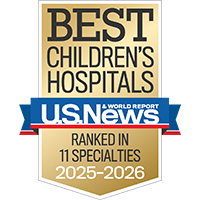Soothing the soul
Our music therapy program nurtures patients with bedside serenades, rap workshops and more.
Find out more

A varicocele is a bunch of enlarged and swollen veins in the scrotum. These veins carry the blood from the testicle back toward the heart. They are similar to varicose veins of the leg. Varicoceles often form during the time of puberty.
If large enough a varicocele can look like a bag of worms. It is usually non painful and mainly on the left side. Some children will have pain or a sensation of fullness when they have a varicocele that often improves when they lie down. Other children who have no symptoms present during a sports physical or a well child exam. It is seen in 15% of boys and usually develops around puberty but it can be seen earlier.
There are many theories about how varicoceles form, but none have been proven. Essentially the veins which take the blood out of the testicle become swollen and full and don’t drain properly, thereby increasing the temperature of the testicle. Varicoceles may inhibit the growth of the testicle during puberty. Varicoceles may also affect sperm development. Varicoceles are seen in 4 out of 10 men presenting to infertility clinics, but not all men with varicoceles have issues with infertility.
Varicoceles are often diagnosed on physical exam. Occasionally they can be found on ultrasounds of the scrotum that are done for other reasons. Often if a varicocele is detected on physical exam an urologist will order a scrotal US to asses the size of the testicles.
Varicoceles are usually surgically managed when there is a >20% size discrepancy between the testicle with the varicocele and the testicle without the varicocele or when the patient has pain. The surgery is called a varicocelectomy. This can be performed with a small incision over the spermatic cord, laparoscopically, or through interventional radiology. The main goal with all these techniques is to tie off or block the veins that are causing the varicocle. The main risks of the procedures include infection at the site of surgery, recurrence of the varicocele, development of a hydrocele (fluid-filled sac around the testicle), and injury to arteries or nerves in that area.
UCSF Benioff Children's Hospitals medical specialists have reviewed this information. It is for educational purposes only and is not intended to replace the advice of your child's doctor or other health care provider. We encourage you to discuss any questions or concerns you may have with your child's provider.

Best in Northern California for urology

Ranked among the nation's best in 11 specialties
Soothing the soul
